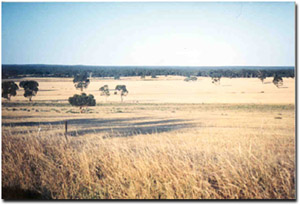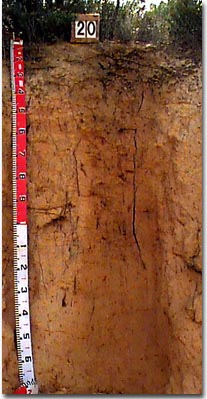Site WW20
Location: Little Desert.
Australian Soil Classificiation: Basic, Arenic, Orthic TENOSOL
Northcote Factual Key: Uc
Great Soil Group: siliceous sand
General Landscape Description: Dune. The deep yellow sand occurs on the dunes of the gently undulating plain (Pg9), gently undulating plains (closer spaced undulations) (Pu9) and gently undulating rises (closer spaced undulations) (Ru9) land units of the Little Desert - Land System 9.
 WW20 Landscape |
Soil Profile Morphology:
Surface Soil
| Ap | 0-20 cm |
|  WW20 Profile |
| A | 20-40 cm |
| |
| |||
| B21 | 40-120 cm |
| |
| B22 | 120-170 cm+ |
| |
Soil Profile Characteristics:
Horizon | pH | Salinity | Sodicity | Dispersion | Internal Drainage | Hydro-phobicity |
Surface (A1 horizon) | moderately acid | very low | - | - | moderately well drained | Severe1 |
Subsoil (B21 horizon) | moderately acid | very low | - | - | ||
Deeper subsoil (at 1 metre) | moderately acid | very low | - | - |
Key Profile Features:
- Deep sand.
- Hydrophobic surface soil.
- Acidic surface soil.
- Acidic subsoil.
Soil Restrictions and Management Prescriptions:
Feature | Result | Management Prescription |
| Sandy surface soil. |
| Horticulture.
|
| Hydrophobic surface soil. |
|
|
| Acidic surface soil. |
|
|
| Acidic subsoil. |
|
|
Land Suitability Rating Table:
LAND USE | SUITABILITY CLASS | MAJOR LIMITING COMPONENT |
| Wheat | 3 | Soil |
| Canola | 3 | Soil |
| Chickpeas | 3 | Soil |
| Lentils | 3 | Soil |
| White clover seed | 3 | Soil |
| Lucerne for seed production | 2 | Climate, landscape, soil |
| Viticulture | 3 | Soil |
| Apples | 3 | Soil |
| Potatoes | 2 | Climate, landscape, soil |
| Carrots | 2 | Landscape, soil |
| Onions | 2 | Climate, landscape, soil |
| Sweet corn | 3 | Soil |
| Radiata Pine | 3 | Climate |
| Blue Gum | 3 | Climate |
Land Suitability Assessment and Primary Limitations:
| Wheat | Climate Landscape Soil | 2* 2 3 | High frost risk for most of the land unit. Water and wind erosion hazard. Deep sandy profile. |
| Canola | Climate Landscape Soil | 2* 2 3 | High frost risk for most of the land unit. Water and wind erosion hazard. Deep sandy profile. |
| Chickpeas | Climate Landscape Soil | 2* 2 3 | High frost risk for most of the land unit, slightly high rainfall. Wind and water erosion hazard. Deep sandy profile. |
| Lentils | Climate Landscape Soil | 2* 2 3 | High frost risk for most of the land unit. Wind and water erosion hazard. Deep sandy profile. |
| White clover seed | Climate Landscape Soil | 2 2 3 |
Wind and water erosion hazard. Deep sands profile. |
| Lucerne for seed production | Climate Landscape Soil | 2 2 2 | Moderate frost risk. Water and water erosion hazard. Sandy subsoil, slightly impeded internal dainage, hydrophobicity, slightly acid. subsoil pH. |
| Viticulture | Climate Landscape Soil | 2* 2 3 | High frost risk for most of the land unit. Water erosion hazard. Deep sandy profile. |
| Apples | Climate Landscape Soil | 2* 2 3 | High frost risk for most of the land unit, slightly high mean maximum January temperature. Water erosion hazard. Deep sandy profile. |
| Potatoes | Climate Landscape Soil | 2 2 2 | Slightly high mean maximum January temperature. Wind and water erosion hazard. Sandy subsoil, slightly impeded internal drainage, hydrophobicity. |
| Carrots | Climate Landscape Soil | 1 2 2 | No major limitation. Water and wind erosion hazard. Slightly impeded internal drainage, hydrophobicity. |
| Onions | Climate Landscape Soil | 2 2 2 | Moderate frost risk. Water and wind erosion hazard. Deep sandy subsoil, slightly impeded internal drainage, hydrophobicity. |
| Sweet corn | Climate Landscape Soil | 1 2 3 | No major limitation. Water and wind erosion hazard. Deep sandy profile. |
| Radiata Pine | Climate Landscape Soil | 3 2 2 | Low rainfall. Water erosion hazard, wind erosion hazard. Sandy subsoil texture, surface soil depth, hydrophobicity. |
| Blue Gum | Climate Landscape Soil | 3 2 2 | Low rainfall. Water erosion hazard, wind erosion hazard. Sandy subsoil texture, surface soil depth, hydrophobicity. |
Profile Described By: David Rees, Nathalie Baxter (January 1997).


